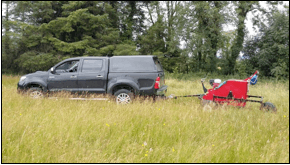Becoming a meadow donor site
Why are meadow donor sites important?
Nationally, we have lost over 97% of our species-rich meadows and the major driver of this is intensive management of agricultural land. Species-rich meadows support a huge diversity of wildflowers, many species of important insects, butterflies, and priority bird species that feed and nest in the sward. We are contacting you as you are the custodian of a rare, very important resource – a species-rich meadow that has potential to help restore other meadows through sowing of your harvested seed. We need your help!
How does seed harvesting work?
Seed harvesting is undertaken using a brush harvester, which brushes the ripe seeds off the top of the plants but does not cut the grass. This means it is compatible with taking hay cuts afterwards. The meadow will normally be ready for seed harvesting in dry weather by mid-July(subject to local prevailing weather conditions), with a normal hay cut a couple of weeks later.
We use a specialist Logik MSH420 harvester trailed behind a small 4X4 that can harvest up to 2 hectares of meadow per day.
Where necessary, we set up the relevant permissions through the Animal and Plant Health Agency (APHA) for seed harvesting and movement of seed, and gain permission from Natural England on Sites of Special Scientific Interest (SSSIs).
Benefits of being a meadow donor site:
- We can offer you up to£70/acre or £175/ha;
- Helping to restore species-rich meadows in your local area and being matched with a local restoration site;
- Provision of local provenance seed for your own meadow restoration projects. We are ecologists, and can offer a great deal of specialist advice;
- We can survey your meadow and provide detailed information of your particular plant community (confidential if necessary). This can help you enter your site into environmental subsidy payment schemes such as ‘GS6 Management of species-rich grasslands’ (£182/ha per year).


Recent Comments